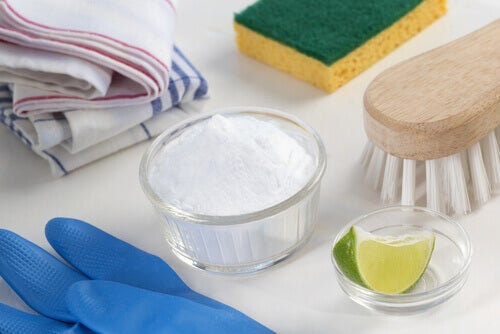Eco Friendly Methods to Clean and Disinfect the Fridge

Everyone with a home should know how to effectively maintain it. Today, we’d like to give you a few ideas on eco-friendly methods you can use to clean and disinfect your fridge. This way, you can keep your fridge clean and maintain the good health of your family and the environment.
In time, a fridge can generate unpleasant odors. Not only that, but the bad smell may linger even after you remove spoiled food or particularly stinky food items. So, to get rid of the bad smell and regain a clean appliance, there are a few eco-friendly methods you can try out.
Eco-Friendly Methods to Clean and Disinfect Your Fridge
First of all, disconnect your fridge before you begin to clean and disinfect it. Leave it off overnight, if possible, to thaw it and release any accumulated ice. Then, remove all the food, drinks, and anything else you may keep in it so you can gain access to every surface in it.
Don’t use chlorine or harsh chemicals to clean your fridge. They’re difficult to eliminate and may contaminate your food, which could lead to infections or other health conditions.
Finally, regardless of how you may choose to clean and disinfect your fridge, you should let it dry entirely before you store food in it again. The food you store, together with any other containers, must be thoroughly cleaned before returning them to the fridge.
This will keep it from contaminating the surfaces you just cleaned.
You may also like to read: Eco-Friendly Decoration: Sustainable Ways To Decorate Your Home
Baking Soda: Always Useful

Every time you clean a fridge, try to use products that make the process more efficient and therefore easier. Baking soda is one of the best eco-friendly methods, and it’s also quite inexpensive. Besides, its degreasing and antibacterial qualities will help you eliminate any traces of food and other accumulated stains and spills.
- Mix two tablespoons of baking soda with a few drops of lemon in a pint of warm water.
- Use it to scrub the fridge inside and out.
- Then, let it sit for five minutes.
- After, it off with a dry cloth.
Salt Water
One of the most ideal eco-friendly methods to clean your fridge is a simple mix made with a handful of salt diluted in a gallon of warm water.
Just dip your sponge in this mix and use it to clean all of the internal and external surfaces. You’ll see how easily you get rid of all traces of food and slime.
Vinegar, an Amazing Antibacterial Agent
Vinegar is another great option for cleaning anything. This wonderful antibacterial agent is one of the best natural disinfectants out there, so it’s particularly good for cleaning even the most contaminated areas.
To make it:
- Mix half a cup of white vinegar in a cup of water.
- Proceed to clean the inside of your fridge.
- Let it sit for five minutes and then wipe off and dry.
- Note: A spray bottle will make this task even easier.
You might be interested: How to Make Eco-Friendly Detergent from Borax and Baking Soda
Olive Oil is a Great Eco-Friendly Method to Clean a Fridge

Four tablespoons of olive oil mixed with three of lemon juice are great for cleaning stainless steel surfaces. This eco-friendly method removes all traces of dirt and spills without leaving a greasy, sticky feeling.
Leave it on for 10 minutes and then wipe it off with a dry cloth.
Tea Tree Oil
Tea tree oil is another powerful natural disinfectant that removes dirt and foul smells.
- Two tablespoons of tea tree essential oil diluted in a cup of warm water are enough.
- You can use a spray bottle for the internal surfaces and then go back and remove any excess with a microfiber cloth.
Lemon Juice to Get Rid of Bad Smells
One of the best eco-friendly methods to eliminate odors from your fridge is to rub its surfaces with a sponge soaked in lemon juice. You should let it sit for five minutes and then wipe it off with a clean, dry cloth.
Its active ingredient is citric acid, which is also an antiseptic, so it’s great for in-depth cleaning. Also, it’ll leave a sparkling clean effect on every surface you clean with it.
You could also pour the juice of three lemons into a spray bottle together with two cups of warm water. Spray it on a surface, let it sit for a few minutes, and then remove it with a dry cloth.
Essential Oils are Wonderful Eco-Friendly Methods
Finally, not only is lemon a good antiseptic, but it also leaves a fresh scent in the fridge.
One way in which you can maximize its freshness is by dipping pieces of cotton in lemon essential oil and then storing it in one of the fridge’s drawers.
Vanilla essential oil is also quite suitable for this task. Also, lemons cut in half with embedded cloves work well.
Charcoal and Onion
A great alternative to eliminate foul smells from your fridge is with a piece of charcoal. There’s no doubt about its effectiveness. Just place it inside the fridge and leave it there.
These 12 eco-friendly methods to clean and disinfect a fridge will give you excellent results. They’re simple, natural, and inexpensive.
Use them consistently and your fridge will be spotless and free of bad odors!
All cited sources were thoroughly reviewed by our team to ensure their quality, reliability, currency, and validity. The bibliography of this article was considered reliable and of academic or scientific accuracy.
- Li He, Zhou Guo-ying, Zhang Huai-yun and Liu Jun-ang. 2011. Research progress on the health function of tea oil. Journal of Medicinal Plants Research. http://citeseerx.ist.psu.edu/viewdoc/download?doi=10.1.1.918.2468&rep=rep1&type=pdf
- Sánchez-Saldaña, L. & Saenz-Anduaga, E. (2005). Antisépticos y
desinfectantes. Dermatología Peruana, 15(2), 82-103. http://metabase.uaem.mx/bitstream/handle/123456789/1468/280_4.pdf - Corral, Laura & Post, Laurie & MONTVILLE, THOMAS. (2006). Antimicrobial Activity of Sodium Bicarbonate. Journal of Food Science. 53. 981 – 982. 10.1111/j.1365-2621.1988.tb09005.x.
- Acetic Acid, the Active Component of Vinegar, Is an Effective Tuberculocidal Disinfectant
Claudia Cortesia, Catherine Vilchèze, Audrey Bernut, Whendy Contreras, Keyla Gómez, Jacobus de Waard, William R. Jacobs Jr., Laurent Kremer, Howard Takiff - Nazzaro, F., Fratianni, F., Cozzolino, R., Martignetti, A., Malorni, L., De Feo, V., Cruz, A. G., & d’Acierno, A. (2019). Antibacterial Activity of Three Extra Virgin Olive Oils of the Campania Region, Southern Italy, Related to Their Polyphenol Content and Composition. Microorganisms, 7(9), 321. https://doi.org/10.3390/microorganisms7090321
- VIUDA‐MARTOS, M., RUIZ‐NAVAJAS, Y., FERNÁNDEZ‐LÓPEZ, J. and PEREZ‐ÁLVAREZ, J. (2008), ANTIBACTERIAL ACTIVITY OF LEMON (CITRUS LEMON L.), MANDARIN (CITRUS RETICULATA L.), GRAPEFRUIT (CITRUS PARADISI L.) AND ORANGE (CITRUS SINENSIS L.) ESSENTIAL OILS. Journal of Food Safety, 28: 567-576. doi:10.1111/j.1745-4565.2008.00131.x
This text is provided for informational purposes only and does not replace consultation with a professional. If in doubt, consult your specialist.








